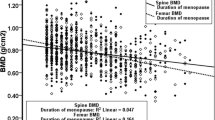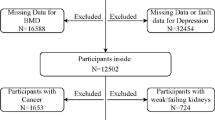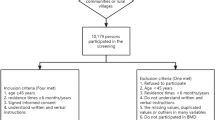Abstract
Summary
The goal of the present study was to examine the relationships of depression, anxiety and stress with bone mineral density (BMD). We hypothesized negative relations between those mood variables and BMD in three assessed areas. The study showed association between depression and decreased BMD. The hypothesis regarding anxiety and stress was partially confirmed.
Introduction
In the last decade, the relationship of osteoporosis to psychological variables has been increasingly studied. The accumulating evidence from these studies supports the conclusion that depression is related to decreased BMD. Nevertheless, several studies found no support for this relationship. Moreover, only a small number of studies examined the association between anxiety or stress and decreased BMD. The goal of the present study was to examine the relationships of depression, anxiety and stress with BMD by means of adequate measuring instruments, while controlling for background factors known to be related to BMD decrease (e.g., body mass index, family history).
Method
The study included 135 post-menopausal female participants, who arrived for BMD screening, between the years 2006 and 2009. Several days prior to the examination, participants completed a series of questionnaires assessing depression and anxiety. BMD was measured using DXA, in spine, right and left hip.
Results
The study showed negative associations between depression and BMD variables in the three assessed areas. There were negative correlations between anxiety, stress and spine BMD, as well as a tendency towards negative relations in the right and left hip BMD. Concurrent hierarchical regressions showed that the addition of the three psychological variables increased the explained variance by 6–8 %. In addition, depression was found to have a unique significant contribution to the explained variance in right and left hip BMD.
Conclusions
The findings provide supporting evidence for the existence of associations between mood variables and decreased BMD. Further research is required for gaining deeper insight into these relationships.

Similar content being viewed by others
References
Pietschmann P, Rauner M, Sipos W, Kerschan-Schindl K (2009) Osteoporosis: an age- related and gender-specific disease – a mini-review. Gerontol 55:3–12. doi:10.1159/000166209
World Health Organization (1994) Assessment of fracture risk and its application to screening for postmenopausal osteoporosis. Technical report series, 843. WHO, Geneva
Coelho R, Silva C, Maia A, Prata J, Barros H (1999) Bone mineral density and depression: a community study in women. J Psychosom Res 46(1):29–35
Lips P, Caulin F, Cooper C et al (1996) The development of a European questionnaire for quality of life in patients with vertebral osteoporosis. Scand J Rheumatol 25:670–675
Wu Q, Magnus JH, Liu J, Bencaz AF, Hentz JG (2009) Depression and low bone mineral density: a meta-analysis of epidemiologic studies. Osteoporos Int 20(8):1309–1320. doi:10.1007/s00198-009-0918-x
Yirmiya R, Bab I (2009) Major depression is a risk factor for low bone mineral density: a meta-analysis. Biol Psychiatry 66:423–32. doi:10.1016/j.biopsych.2009.03.016
Williams LJ, Pasco JA, Jacka FN, Henry MJ, Dodd S, Berk M (2009) Depression and bone metabolism. A review. Psychother Psychosom 78:16–25. doi:10.1159/000162297
Laudisio A, Marzetti E, Cocchi A, Bernabei R, Zuccalà G (2008) Association of depressive symptoms with bone mineral density in older men: a population-based study. Int J Geriatr Psychiatry 23(11):1119–11126. doi:10.1002/gps.2037
Kritz-Silverstein D, Barrett-Connor, E (1997) Depressed mood and bone mineral density in older men and women: the Rancho Bernardo study. J Bone Miner Res 12S1: S251
Reginster JY, Deroisy R, Paul I, Hansenne M, Ansseau M (1999) Depressive vulnerability is not an independent risk factor for osteoporosis in postmenopausal women. Maturitas 33:133–137
Mezuk B, Eaton WW, Golden SH, Wand G, Lee HB (2008) Depression, antidepressants, and bone mineral density in a population-based cohort. J Gerontol A Biol Sci Med Sci 63(12):1410–1415
Lyles KM (2001) Osteoporosis and depression: shedding more light upon a complex relationship. J Am Geriatr Soc 49:827–828. doi:10.1046/j.1532-5415.2001.49162.x
Schweiger U, Deuschle M, Korner A, Lammers CH, Schimder J, Gotthardt H, Holsboer F, Heuser (1994) Low lumbar bone mineral density in patients with major depression. Am J Psychiatry 151(11):1691–1693
Vrkljan M, Thaller VM, Lovricevic I, Gacina P, Resetic J, Bekic M, Sonicki Z (2001) Depressive disorder as possible risk factor of Osteoporosis. Coll Antropol 25(2):485–492
Gold DT (1996) The clinical impact of vertebral fractures: quality of life in women with osteoporosis. Bone 18(3):185S–189S
Falch JA, Bentzen H, Dahl AA (2003) Pain, functional level and emotional problems of women with osteoporosis and vertebral fractures. Tidsskr Nor Laegeforen 123(23):3355–3357
Clarke DM, Currie KC (2009) Depression, anxiety and their relationship with chronic diseases: a review of the epidemiology, risk and treatment evidence. Med J Aust 190(7):S54–S60
de Oliveira FN, Arthuso M, da Silva R, Pedro AO, Neto AM, Costa-Paiva L (2009) Quality of life in women with postmenopausal osteoporosis: correlation between QUALEFFO 41 and SF-36. Maturitas 62(1):85–90. doi:10.1016/j.maturitas.2008.10.01
Salaffi F, Cimmino MA, Malavolta N, Carotti M, Di Matteo L, Scendoni P, Grassi W (2007) The burden of prevalent fractures on health-related quality of life in postmenopausal women with osteoporosis: the IMOF study. J Rheumatol 34(7):1551–1560
Zonis De Zukerfeld R, Ingratta R, Sanchez Negrete G, Matusevich A, Intebi C (2004) Psychosocial aspects in osteoporosis. Vertex 54:253–259
Muhsen K, Lipsitz J, Garty-Sandalon N, Gross R, Green MS (2008) Correlates of generalized anxiety disorder: independent of co-morbidity with depression: findings from the first Israeli National Health Interview Survey (2003–2004). Soc Psychiatry Psychiatr Epidemiol 43(11):898–904
Williams LJ, Bjerkeset O, Langhammer A, Berk M, Pasco JA, Henry MJ, Schei B, Forsmo S (2011) The association between depressive and anxiety symptoms and bone mineral density in the general population: The HUNT Study. J Affect Disord 131(1–3):164–171
Zung WW (1965) A self rating depression scale. Arch Gen Psychiatry 12:63–70
Biggs JT, Wylie L, Ziegler VE (1978) Validity of the Zung self rating depression Scale. Br J Psychiatry 132:381–385
Spielberger CD, Barker LR, Russell SF, Crane RS, Westberry LG, Knight J, Marks E (1979) The Preliminary Manual for the State–Trait Personality Inventory. Unpublished manual, University of South Florida, Tampa, FL
Cohen S, Kamarck T, Mermelstein R (1983) A global measure of perceived stress. J Health Soc Behav 24:385–396
Cole SR (1999) Assessment of differential item functioning in the Perceived Stress Scale-10. J Epidemiol Community Health 53(5):319–320
Cohen S, Sherrod DT, Clark M (1986) Skill and the stress protective role of social support. J Pers Soc Psychol 50:963–973
Mezuk B, Eaton WW, Golden SE (2008) Depression and Osteoporosis: epidemiology and potential mediating pathways. Osteoporos Int 19:1–12. doi:10.1007/s00198-007-0449-2
Papanicolaou DA, Wilder RL, Manolagas SC, Chrousos GP (1998) The pathophysiologic roles of interleukin-6 in human disease. Ann Intern Med 128:127–137
Kiecolt-Glaser JK, McGuire L, Robles TF, Glaser R (2002) Emotions, morbidity, and mortality: new perspectives from psychoneuroimmunology. Annu Rev Psychol 53:83–107
Cizza G, Primma S, Csako G (2009) Depression as risk factor for osteoporosis. Trends Endocrinol Metab 20(8):367–373. doi:10.1016/j.tem.2009.05.003
Altindag O, Altindag A, Asoglu M (2007) Relation of cortisol levels and bone mineral density among premenopausal women with major depression. Int J Clin Pract 61:416–420
Herran A, Amado J, Garcia-Unzueta M et al (2000) Increased bone remodeling in first-episode major depressive disorder. Psychosom Med 62:779–782
Kahl K, Rudolf S, Stoeckelhuber B et al (2005) Bone mineral density, markers of bone turnover, and cytokines in young women with borderline personality disorder with and without comorbid major depressive disorder. Am J Psychiatry 162:168–174
Yirmiya R, Goshen I, Bajayo A, Kreisel T, Feldman S, Tam J, Trembovler V, Csernus V, Shohami E, Bab I (2006) Depression induces bone loss through stimulation of the sympathetic nervous system. Proc Natl Acad Sci U S A 103(45):16876–16681
Ducy P, Karsenty G (2010) The two faces of serotonin in bone biology. J Cell Biol 191(1):7–13. doi:10.1083/jcb.201006123
Cocchi M, Tonello L, Gabrielli F (2011) Pregnolato M (2011) Depression, osteoporosis, serotonin and cell membrane viscosity between biology and philosophical anthropology. Ann Gen Psychiatry 10:9. doi:10.1186/1744-859X-10-9
Cauley J, Fullman R, Stone K (2005) Factors associated with the lumbar spine and proximal femur bone mineral density in older men. Osteoporos Int 16:1525–1537
Diem SJ, Blackwell TL, Stone KL, Yaffe K, Haney EM, Bliziotes MM, Ensrud KE (2007) Use of antidepressants and rates of hip bone loss in older women. Arch Intern Med 167:1240–1245
Richards J, Papaioannou A, Adachi J, Joseph L, Whitson HE, Prior JC, Goldzman D (2007) Effect of selective serotonin reuptake inhibitors on the risk of fracture. Arch Intern Med 167(2):188–194
Haney EM, Warden SJ (2008) Skeletal effects of serotonin (5-hydroxytryptamine) transporter inhibition: evidence from clinical studies. J Musculoskelet Neuronal Interact 8(2):133–145
Kaufman J, Charney D (2000) Comorbidity of mood and anxiety disorders. Depression and anxiety. Depress Anxiety 12:69–76
Apóstolo JLA, Figueiredo MH, Mendes AC, Rodrigues MA (2011) Depression, Anxiety and Stress in Primary Health Care Users. Rev Lat Am Enfermagem 19(2):348–353
Acknowledgments
This study supported by a grant from Myers-JDC-Brookdale Institute of Gerontology and Human Development, and Eshel, the Association for the Planning and Development of Services for the Aged in Israel.
Conflict of interest
None.
Author information
Authors and Affiliations
Corresponding author
Rights and permissions
About this article
Cite this article
Erez, H.B., Weller, A., Vaisman, N. et al. The relationship of depression, anxiety and stress with low bone mineral density in post-menopausal women. Arch Osteoporos 7, 247–255 (2012). https://doi.org/10.1007/s11657-012-0105-0
Received:
Accepted:
Published:
Issue Date:
DOI: https://doi.org/10.1007/s11657-012-0105-0




